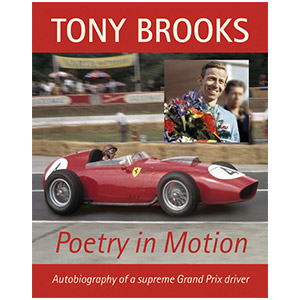Tony Brooks – Poetry in Motion
Autobiography of a Supreme Grand Prix Driver
Hardcover, 276 Pages
ISBN: 9781899870837
Publisher:https://www.quartoknows.com/books/9781899870837/Tony-Brooks.html?direct=1
Illustrations: 250 b/w & color photos
Published: May 1st 2012

Book Review
“The best driver the world doesn’t know about”. That is how Sir Stirling Moss described Tony Brooks, a virtuoso sports car and Grand Prix driver of the golden era.
His long awaited autobiography does not disappoint – for those who enjoy statistics, Brooks shows that he kept a racing diary second to none. For those who enjoy anecdotes, the stories give more than a few laugh-out-loud moments. For those who enjoy racing history, its rich text and comparisons with contemporaries as well as the modern sport, give real insight. For those who like to peruse casually, there are many photographs, most from Brooks’ family archive and never before seen.
The story starts at the beginning and chronicles Brooks’ studious nature and happy supportive home life, setting him up for his successes as a driver, team diplomat, businessman and his most important role, as a family man.
It is well known that Brooks studied as, and later became a dentist, although he would never practice as such. He started out on two wheels, learning his craft on motorcycles while traversing country roads before transferring to the relative safety of a car – his first race taking place at the wheel of his mother’s Healey Silverstone. Due to the lack of available finance, Tony was forced to drive with care and mechanical sympathy in order that his steed would be available for the next event…not to mention for his mother to be able to get to town! It was his care and attention that earned him his reputation as a “safe pair of hands” and invitations to drive others cars materialized enabling young Brooks to take the next step up the proverbial ladder.
Brooks is very analytical and imparts to the reader detailed accounts of how his style progressed and the techniques he used to get the most out of his machinery. He chronicled his own progress by way of improved lap times at each circuit instead of race wins, which did not come right away as he was racing for class rather than overall honors.
Tony’s modesty is evident when he talks about the first time he wore racing overalls, “Racing overalls were something to be earned, not worn to bounce around the paddock with a ‘look at me, I’m a racing driver’ air, while still metaphorically wearing ‘L’ plates (big red “L”stickers on the front and rear of student drivers’ road cars in the UK. JE). It was not until the BRDC accepted me as a member that I felt justified in wearing racing overalls.” After testing for Aston Martin at a wet and cold Chalgrove, he finally felt justified in wearing his ‘uniform’ when he was retained by John Wyer for the 1955 season for the princely sum of £50, his first race for the equipe being the ill-fated and tragic Le Mans race.
His humility is further evidenced during the read when he fails to ever sing his own praises, preferring to cite period race reports to highlight his growing prowess behind the wheel. Tony’s love of driving and the pleasure he derived from it is obvious in his prose. He loved the challenging and fast road circuits over the flat and featureless aerodromes and tells of how drifting his Aston around Spa in a rhythmic series of corners and bends as “inducing a state of ecstasy”. He wrote a motoring column for the newspaper “The Observer” for many years and is no slouch behind the keyboard. His insights into the psyche of many of his friends and colleagues of the time are quite revealing as he tells of the personal fears and concerns of the drivers as they wrestled with the demons induced by the stress of the racing era. Can you imagine a single stint of 30 laps at Le Mans, compared to the 10 or so they drive today?
As well as the personal observations, Brooks gives great race details such as how a Peugeot drove the DBR1 off the road at the ‘Ring in 1958. Also how he was excused from Le Mans 1959 – a race he hated – when with Ferrari, and how the cars were way under geared, Behra being unwilling to stick to the 7500 rpm limit, his tach telltale showing 9300rpm when the engine blew causing a furious row with team manager Tavoni. I’ve read all the books, and I’ve never seen some of these gems.
Tony drove at the height of the ‘Golden Era’ and then moved into the early rear engined machines, but his unlucky decisions with the wrong teams as well as poor team tactics show what a huge disappointment his final two seasons were, the reader almost able to feel him biting his tongue when discussing his final year with BRM. It is also obvious that in retrospect the front engine cars with which he had so much success gave him a lot more driving pleasure.
Tony’s romance and ultimate marriage to his Italian wife Pina is a delightful thread that runs through the book, and he tackled family life with the same style with which he created poetry in his cars. His life as a businessman in the motor trade is also detailed and is a nice close to this most delightful and talented driver’s story.
For the casual modern Aston fan, this book may not hold too much interest, but for those die hards of the marque (this word chosen intentionally instead of ‘brand’!) and those with a keen interest in motor racing history, this book is an absolute must have.


